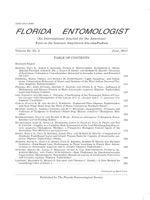The Brazilian Amazon harbors a high diversity of fruit flies in the genus Anastrepha Schiner (Diptera: Tephritidae) with 53 of the 103 described species reported in Brazil, and 12 Anastrepha species occur exclusively here (Zucchi et al. 1996; Silva & Ronchi-Teles 2000; Zucchi 2008).
In the Central Amazon, most fruit fly studies have been carried out in agroforestry systems (Silva et al. 1996; Zucchi et al. 1996) or with traps (Ronchi-Teles & Silva 2005), and the only study on fruit flies in an unperturbed forest area focused on parasitoids (Costa et al. 2009). Thus, the information on host/fruit fly/parasitoid associations is still limited.
In this study, we documented fruit fly-host associations for Anastrepha species for both the Central Amazon and Brazil, and identified the braconid larval-pupal parasitoids associated with Anastrepha.
Our study site was located in a 30 km2 area of the Reserva Florestal Adolpho Ducke (RFAD) of the Instituto Nacional de Pesquisas da Amazônia (INPA), located northeast of Manaus (02°53′S and 59°59′W) in the state of Amazonas, Brazil. The area is primary forest of about 100 km2. The mean annual temperature is 26.5°C, with a monthly mean maximum of 38.6°C (Dec) and minimum of 18.2°C (Jul) and mean annual relative humidity of 82% (Araújo 1970). Samples of ripe or ripening fallen fruit were collected randomly at the ground level under the canopies every 2 weeks from Oct 2002 to Jun 2003, from Mar to May 2009, and from Mar to May 2010. The fruits were collected inside the forest in an area of about 30 km2 where all tree species had already been identified by botanists from Instituto Nacional de Pesquisas da Amazônia (INPA). The collected fruits were counted, weighed, and placed in plastic containers with a layer of vermiculite and covered with voile cloth until larvae emerged and pupated. All pupae obtained were placed in 30-mL plastic containers with a layer of vermiculite at the bottom and covered with voile cloth until adults emerged. Voucher specimens were deposited at the Coleção de Invertebrados of INPA.
We collected a total of 63.7 kg of fruit from 50 plant species in 18 families. A total of 1,398 fruits weighing 19.7 kg from 13 species in 7 families were infested by fruit flies, with a total of 880 puparia recovered (Table 1). We report for the first time field infestations under natural conditions by Anastrepha pulchra Stone on Mouriri collocarpa Ducke (Melastomataceae), a native tree species, and its associated parasitoid Doryctobracon areolatus (Szépligeti) (Hymenoptera: Braconidae) in Brazil. Anastrepha pulchra has been reported in Panama, Venezuela, and Brazil (Amazon) (Norrbom 2002).
We also report 2 new hosts for Anastrepha atrigona Hendel: Strychnos jobertiana Baillon (Loganiaceae) and Pouteria durlandii (Standley) Baehni (Sapotaceae). Three hymenopteran parasitoid species, Opius bellus Gahan, Opius sp. (Braconidae), and Aganaspis pelleranoi (Brèthes) (Figitidae), are associated with A. atrigona for the first time. Anastrepha atrigona has been reported only in Venezuela, Guyana, Surinam, and Brazil (state of Amazonas) to date (Norrbom et al. 1999; Zucchi 2008).
We found 1 new host for Anastrepha bahiensis Lima, Helicostylis scabra (Macbride) Cornelis Christiaan Berg (Moraceae). Anastrepha bahiensis has been found from Mexico to Brazil (several states) (Norrbom et al. 1999; Zucchi 2008). Four other described species, Anastrepha bondari Lima, Anastrepha coronilli Carrejo & González, Anastrepha obliqua Macquart, and Anastrepha striata Schiner were found in this study and have already been reported for the hosts listed on Table 1 and numerous other hosts in previous studies (Norrbom 2002; Zucchi 2007, 2008) (Table 1). Four presumed new species of Anastrepha, yet to be described, were reared from single species of Anonaceae and Bignoniaceae, and 2 species of Sapotaceae, respectively (Table 1).
Three species of braconids (D. areolatus, Opius sp., and O. bellus) and 2 species of figitids (Aganaspis nordlanderi Wharton and A. pelleranoi) were associated with Anastrepha species. This is the first report of A. nordlanderi parasitizing Anastrepha coronilli. The braconids and figitids reported in this study previously were found associated with other Anastrepha species (Canal & Zucchi 2000; Guimarães et al. 2000; Ovruski et al. 2000)
TABLE 1.
ANASTREPHA SPECIES and ASSOCIATED PARASITOIDS COLLECTED IN CENTRAL AMAZON, BRAZIL.

We thank Claudemir M. Campos and Ulisses G. Neiss for help during the collections and José Lima for help with plant identification, and Carter R. Miller, Gary J. Steck, and 2 anonymous reviewers for comments on an earlier version of the manuscript. This study had financial support from CNPq (Conselho Nacional de Desenvolvimento Científico e Tecnológico - grant n°575664/ 2008-8).
SUMMARY
A natural host (Mouriri collocarpa) and a parasitoid (Doryctobracon areolatus) for Anastrepha pulchra are reported for the first time in Brazil. We report new hosts for Anastrepha atrigona and Anastrepha bahiensis in the Brazilian Amazon. Parasititoids attacking A. atrigona, Anastrepha coronilli, and A. pulchra are reported.





